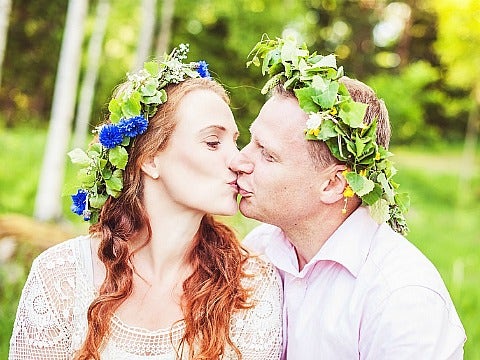Why The Summer Solstice Is The Perfect Day For Love
The longest day of the year may also be the hottest day of the year — for love.

The summer solstice is here and if ancient tradition proves right, today could be the best day of the year for romance. The summer solstice, derived from Latin words sol ("sun") and sister ("to stand still"), is the longest day of the year in the Northern hemisphere when daylight lasts over 15 hours.
This astronomical event usually takes place around June 21 and has long been associated with love, sexuality and fertility. One reason is because people wanted to ensure that their children would be born in the springtime, when they would have a better shot at staying healthy, says Barbara Biziou, ritualistic expert and author of The Joy of Ritual. "Spiritually, the summer solstice is a time when Cancer, the nurturing feminine energy, is entering the world and the season of harvest begins. Therefore, it’s a great time for love and sexuality."
Donna Henes, an Urban Shaman, multicultural ritual expert and author of Celestially Auspicious Occasions: Seasons, Cycles and Celebrations, agrees. "In ancient times, when we didn't have light and heat indoors or stores where we could buy food, winter was a bare, cold and very hard time," Henes says. "If your baby was born in the beginning of winter, it had a much less chance of survival. It became a tradition to have mating season around the solstice so your child would be born in early spring instead. This is where the June wedding legacy comes from."
"Now, June not only is wedding season but also Gay Pride," says Henes. "That is not an accident either — it's all about that coming together with that powerful force of energy and love makes the world go around, and the world goes around the sun.“
Henes also describes the solstice as a lover's holiday which coincides with nature's harvest. "The relationship between the solstice and the powerful, fertile energy of the sun is reflected in nature," she says. "Flowers are the sexual organs of the plants. Not only is nature blooming and the sap rising, but the libido rises as well."
Throughout our civilization, the summer solstice has been celebrated as a major holiday by cultures around the globe. The Chinese honored Li, the Chinese Goddess of Light, and the Druids believed it was a marriage of masculine and feminine dieties, or the wedding of heaven and Earth. Ancient Pagans celebrated the solstice with bonfires where pairs of lovers would jump through the flames for good luck. They called the midsummer moon the "Honey Moon," using honey in wedding ceremonies in June. They also wore gardlands of herbs and flowers to ward away evil spirits because they believe it was a magical time.
The summer solstice is especially significant in Sweden where it is called Midsummer, and a tree was set up and decorated in each town for the villagers to dance around. "There is a sweet Swedish proverb that says midsummer's night isn’t long but it sets many cradles rocking," says Henes. Shakespeare's famous play, A Midsummer Night’s Dream, was about the solstice and Midsummer Festivals still take place in Europe to mark the occasion.
"It was considered lucky to mate at the summer solstice," said Henes. "In Egypt, there was a special ceremony at the temples that were dedicated to the goddess Vesta and her vestal Virgins, where the fires would be extinguished and rekindled. There was a saying that you shouldn't mate until the ashes from Vesta's fire are washed down the Nile. That would signal to folks that it was time."
In New Orleans about a century ago, Henes explains that the Voodoo Queen performed a snake-like dance called the Calinda dance to represent sexual, slithering energy. Everyone would partake in the celebration at the square — slaves, ex-slaves, Creoles, etc. — which was marked by frenzied drum beats, bonfires, swirling dances and imitation of sacred African serpent affects. "There would be crowds and crowds fueling the heat," Henes says.
Summer solstice isn't only for mating couples, it is also traditionally a magical time for singles who hopes to meet "the one". "It's a sexual union holiday for people who are already connected but also for single people," Henes says. "It was a time for singles to pray, chant and do charms to bring their lovers to them." Henes says that young girls would often "cast spells to bring them their own true love" by wearing special charms on their heart or keeping them under their pillow. Another ritual was for young girls to peel an apple in a circular motion until they had a long spiral of skin. "As it falls to the ground," says Henes, "they're supposed to look to see if they can see the initials of their future lover in the apple peel."
More stories from YourTango:
- Love Quotes On YourTango
- The Best Sex Advice On YourTango
- I Love You: 15 Ways Guys Say It Without Saying It
Biziou tells of another Italian tradition where one exchanges a pot of basil and cucumbers with their significant other. If the plant grows thick, love will grow in joy and happiness. Biziou recommends using herbs to harness the energy of the solstice. Her favorites are lilies, which are said to heal the pain of a broken heart, lavender for love and harmony, and chickweed which is an herb worn to attract love.
"The bottom line is that this is the most powerful and potent day of the year," Henes says. "This is as good as it gets and then the sun starts declining. There's a direct association with the potency with sexuality and reproduction, love, lust and passion."
So, couples and singles for love: light a fire, get out some herbs, wear your trendy headpiece, go out and dance, and get ready for love — the summer solstice is here.

